War Coverage Shifts Amid Bias Complaints
Should Inquirer Have Apologized for Cartoon?
FDA Considers Banning Some Hair Straighteners
‘I Had Employees Call Me the N-word to My Face’
Nonprofit Newsrooms More Diverse Than Others
Natives Weigh In on ‘Killers of the Flower Moon’
Harry Porterfield Dies, ’85 Demotion Led to Boycott
(more to come)
Support Journal-ismsDonations are tax-deductible.
Despite efforts to flee, many civilians are trapped in Gaza. CNN producer Ibrahim Dahman shares his story. (Credit: YouTube)
War Coverage Shifts Amid Bias Complaints
“The developing status of this war illustrates just how quickly perceptions about who has the moral high ground can evolve in conflicts like this,” columnist Charles M. Blow wrote for The New York Times. It was but one of a few truisms capturing the moment in this stage of the Israeli-Hamas war.
Another: “Words matter. Timing matters. This war is as much about propaganda as it is about anything else,” wrote Leonard Greene in the Daily News of New York.
A third: “Our institutions are meeting this moment not with clarity, but with double standards.” That was from Karen Attiah of the Washington Post, writing in her newsletter.
Topic A in coverage of the coverage was the deadly explosion at al-Ahli Hospital in Gaza City on Oct. 18. Assignment of blame and acknowledgment of the humanitarian disaster helped shift perceptions of who held the moral high ground. At least 24 journalists had already been killed in this war as of Tuesday, most of them Palestinians, and now journalistic standards themselves were taking a hit.
[On Wednesday, “Al Jazeera said its bureau chief in Gaza, Wael Al Dahdouh, lost his wife, son, daughter, and grandson in what it said was an Israeli airstrike,” CNN reported. “The blast hit a house in the Nuseirat refugee camp in central Gaza where the family was taking shelter after being displaced, according to the news organization”].
“Most news organizations seem eager to sweep last week’s negligent coverage of the Gaza hospital explosion under the rug, moving on from the low moment covering the Israel-Hamas war without admitting any mistakes,” Oliver Darcy wrote Monday night for CNN.
“While The New York Times and BBC — both of which faced enormous scrutiny for their coverage of the blast — have in recent days issued mea culpas, the rest of the press has remained mum, declining to explain to their audiences how they initially got an important story of such great magnitude so wrong.
“On Monday, I contacted the major news organizations that amplified Hamas’ claims, which immediately assigned blame to Israel for the blast that it said had left hundreds dead. Those organizations included CNN, the Associated Press, Reuters, Al Jazeera, and The Wall Street Journal. . . . if there was even a morsel of contrition from news organizations that breathed considerable life into Hamas’ very different version of events, it hasn’t been shown. . . . “
[“CNN has now added a correction to their online article about the hospital explosion, admitting they failed to attribute initial claims about it to Hamas,” Ken Meyer reported Wednesday for Mediaite.]
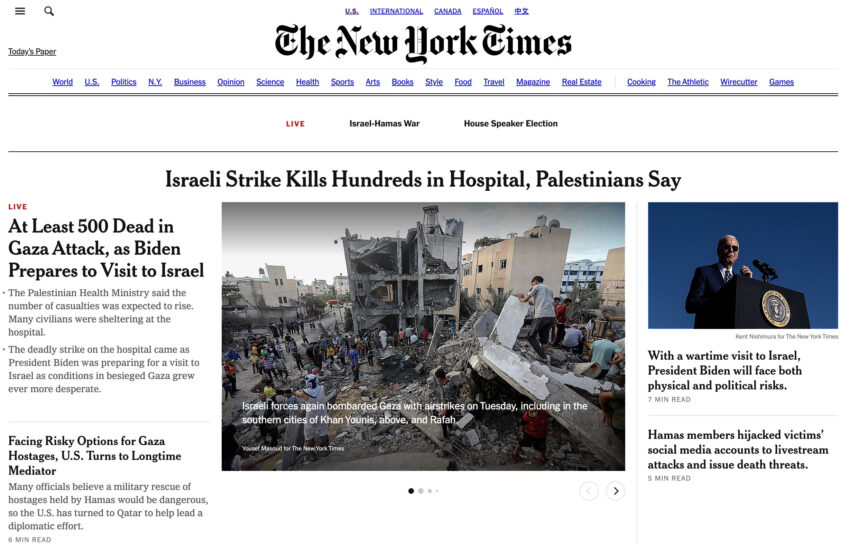
New York Times columnist Thomas Friedman said on the paper’s Matter of Opinion podcast Friday, “It immediately went around the world, headlines everywhere — Israel attacks hospital — including in a newspaper that we know very well. And by the time the truth had a chance to put its shoes on, this inflamed the entire Arab world.”
Charlotte Klein reported Tuesday for Vanity Fair, “A series of Slack messages obtained by Vanity Fair shows there was immediate concern inside The New York Times over the paper’s presentation of the Gaza hospital bombing story. But senior editors appear to have dismissed suggestions from an international editor, along with a junior reporter stationed in Israel who has been contributing to the paper’s coverage of the war, that the paper hedge in its framing of events. . . .”
Then there was the story about the beheading of children. “There have been verified reports that Hamas, which attacked Israel on Oct. 7, committed violence against children,” Sara Swann reported Tuesday for the Poynter Institute’s PolitiFact. ‘But one particularly disturbing claim — that the Palestinian militant group beheaded dozens of babies — gained prominence in the days after the massacre, amplified at the U.S. and Israeli governments’ highest levels. This report remains unverified.
“Since the attack, the claim has been widely repeated by politicians including President Joe Biden, Rep. Marjorie Taylor Greene, R-Ga., and Rep. Elise Stefanik, R-N.Y.; news outlets, such as CNN, Fox News and the New York Post; Israeli officials, including the prime minister’s office; actor Noah Schnapp and other social media users with large followings. . . .”
On Monday, Steven Erlanger of The New York Times wrote that the war “has been a crushing blow to a host of assumptions that have defined the Israeli-Palestinian conflict for years.” He listed them: “Hamas could be contained and the conflict managed.” “Israel is invincible and maintains military superiority.” “The Arab world is moving on, despite the Palestinians.” and “America can ignore the Middle East.”
Language, too, has become part of the battle. “Were they ‘terrorists’? Anchors on CNN and Fox News said they were,” Paul Farhi wrote in The Washington Post.
“Or were they ‘militants’ (The Washington Post, BBC)?
“Or ‘gunmen’ (NPR)? Or ‘fighters’ (Al Jazeera English)?
“Were they the foot soldiers of a ‘terrorist organization’ (Business Insider) or of ‘the governing power in the Gaza Strip’ (the New York Times)?
“Words matter, particularly to news organizations that try to preserve accuracy and impartiality at moments of great passion and uncertainty. A badly chosen word in a media account — particularly during a bloody conflict involving Israelis and Palestinians — can elicit swift denunciations from readers, listeners and viewers.”
WBZ in Boston reports on Dave Chappelle’s remarks on the Israel-Hamas war.
One of the most dishonest examples of “spin” was Fox News’ account of comedian Dave Chappelle’s remarks in Boston.
A Fox News headline claimed, “Audience walks out on Dave Chappelle after he criticizes Israel during show in Boston: Report.”
But the actual “report,” in the last paragraph of a Wall Street Journal story, said, “Chappelle show attendees said the crowd appeared mostly supportive of his comments, and many shouted ‘Free Palestine.’ A small faction of attendees got up and left the show while a handful shouted, ‘What about Hamas?’ attendees said.”
Journalists lost jobs or quit them over news organizations’ word or story choices.
All 65 daily newspapers owned by investment firm Alden Global Capital — including the Chicago Tribune, Daily News in New York and the Baltimore Sun — ran an editorial Oct. 18 urging the news media to describe Hamas as a terrorist organization and its Oct. 7 attack as a terrorism.
Some outlets gave voice to second thoughts. The Philadelphia Inquirer apologized to readers on Oct. 18 for running a cartoon by Monte Wolverton of the Cagle Cartoons syndicate. “In hindsight, the cartoon depicting an oversized Israeli military boot stepping on Hamas terrorists hiding among civilians in response to the Oct. 7 attack should not have been published,” an editorial said. “Regardless of the interpretation, the illustration reinforces pernicious antisemitic tropes about Israeli aggression.”

Others want to play hardball. Shloma Karhi, Israel’s communications minister, is seeking a possible closure of Al Jazeera’s local bureau, and accused the Qatari news station of pro-Hamas incitement and of exposing Israeli soldiers to potential attack from Gaza. “Last week, those regulations started to take shape,” the Times of Israel reported.
Perhaps the biggest shifts in coverage have come in the insertion of missing context, the increasing willingness to distinguish between Hamas and the Palestinian people and in heeding pleas to cover the suffering of Palestinians with as much compassion as that given to Israelis.
In the Los Angeles Times, LZ Granderson wrote Oct. 18, “To a certain kind of educated younger audience, the modern state of Israel looks a lot like yet another byproduct of European imperialism. They aren’t all wrong about that. There was the British Mandate for Palestine in 1923, which set the stage for dueling Palestinian and Jewish nationalist movements. Before settling on land in the Middle East, one Zionist leader proposed territory in what’s now Kenya as a possible safe haven for Jews — as if the land in question were unoccupied and England’s to offer. . . .”
Many news outlets reported on pro-Israeli or pro-Palestinian rallies on college campuses, but Howard University’s The Hilltop wrote about the absence of them on its campus, surprising given the college’s history.
“Michael Fischbach, a historian with a focus on Israel and Palestine, said the relationship between Howard student activists and Palestinians spans decades, beginning with Black revolutionaries in the late 60s and early 70s who embraced the Palestinian struggle for liberation,” Jasper Smith wrote.
“Since 1948, when the state of Israel was created, tens of thousands of Palestinian civilians have been killed, Fischbach said, leading Black civil rights organizers and student activists to advocate for the life and rights of Palestinians.
Kwame Ture, known as Stokely Carmichael when he was making headlines in the 1960s, was a supporter of Palestinians. In this undated clip, he explains his views on the difference between Judaism and Zionism. (Credit: YouTube)
“ ‘People like the Black Panther Party, Stokely Carmichael, SNCC embraced the Palestinian cause, not just out of abstract revolutionary solidarity, but because they saw themselves as a kindred people of color fighting a global system of oppression that was backed by the United States,’ Fischbach, author of ‘Black Power in Palestine,’ told The Hilltop . . . .
“According to researchers at Florida Atlantic University, private HBCUs like Howard and Hampton University became a refuge for Jewish professors and scholars seeking opportunities free of discrimination in the 1930s,” the story continued, referring to historically Black colleges and universities.
“ ‘While most of these pairings between Jewish refugees and Black colleges began as marriages of convenience, very often they blossomed into matches that lasted a lifetime,’ Linda Medvin, director of the Center for Holocaust and Human Rights Education at Florida Atlantic University, wrote. . . . “
News organizations don’t report in a vacuum. If the initial mainstream reporting was reflective of the “I Stand with Israel” pronouncements of President Biden and other American leaders, in recent days more of it reflected the “I Stand with Israel — but” of former president Barack Obama.
“In dealing with what is an extraordinarily complex situation where so many people are in pain and passions are understandably running high, all of us need to do our best to put our best values, rather than our worst fears, on display,” Obama wrote on Medium on Monday.
“That means actively opposing anti-semitism in all its forms, everywhere. It means rejecting efforts to minimize the terrible tragedy that the Israeli people have just endured, as well as the morally-bankrupt suggestion that any cause can somehow justify the deliberate slaughter of innocent people.
“It means rejecting anti-Muslim, anti-Arab or anti-Palestinian sentiment. It means refusing to lump all Palestinians with Hamas or other terrorist groups. It means guarding against dehumanizing language towards the people of Gaza, or downplaying Palestinian suffering — whether in Gaza or the West Bank — as irrelevant or illegitimate.
“It means recognizing that Israel has every right to exist; that the Jewish people have claim to a secure homeland where they have ancient historical roots; and that there have been instances in which previous Israeli governments made meaningful efforts to resolve the dispute and provide a path for a two-state solution — efforts that were ultimately rebuffed by the other side. . . .”
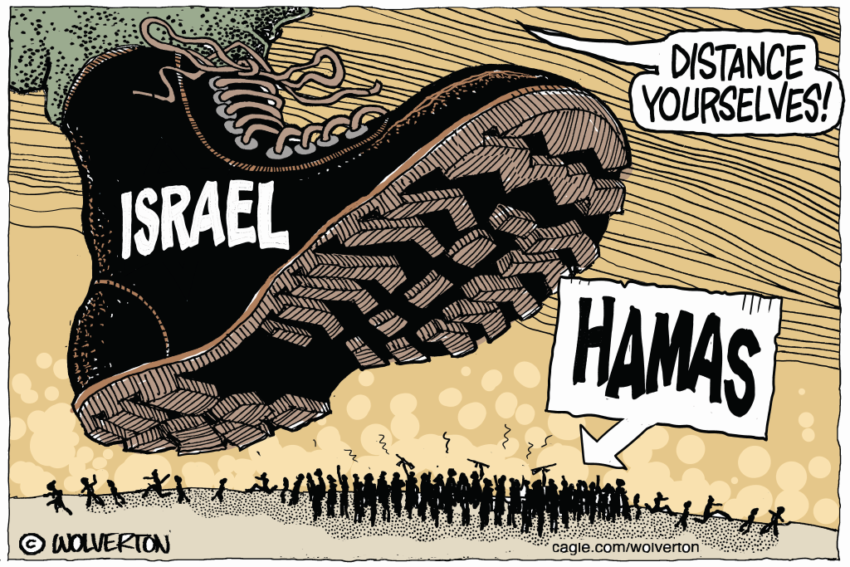
Should Inquirer Have Apologized for Cartoon?
The Philadelphia Inquirer last week took the rare step of apologizing for publishing a cartoon. Monte Wolverton of the Cagle Cartoons syndicate depicted an oversized Israeli military boot stepping on Hamas terrorists hiding among civilians. The boot was at first labeled with the Star of David, which was changed to the word “Israel” because some might equate the Star of David with all Jews, not just Israelis or the Israeli government.
“It is clear this cartoon was highly insensitive, particularly at the current moment when antisemitism is on the rise. We hear the outcry and apologize for the pain it caused,” the Inquirer declared Oct. 18.
“We are reviewing the totality of our processes — particularly those for the selection of illustrations and cartoons — to prevent failures like this one from occurring again. We welcome your feedback, and we look forward to continuing the conversation.”
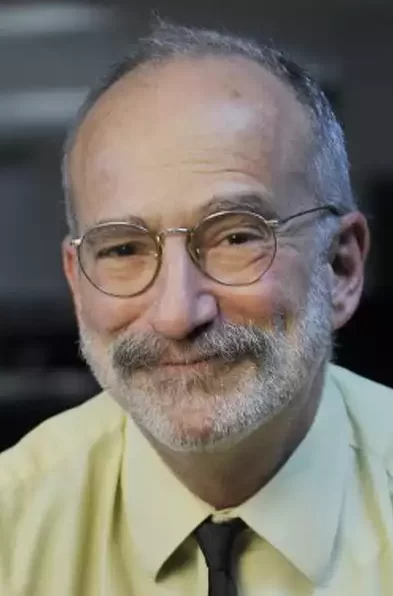 When the editorial was posted on a listserve for opinion writers, the most complete reaction came from Jay Jochnowitz (pictured), retired editorial page editor of the Albany (N.Y.) Times Union, now editor-at-large:
When the editorial was posted on a listserve for opinion writers, the most complete reaction came from Jay Jochnowitz (pictured), retired editorial page editor of the Albany (N.Y.) Times Union, now editor-at-large:
“The whole discussion is fraught,” Jochnowitz wrote. “There’s the atrocity of Hamas’ acts of terrorism, there’s the dilemma of how [to] respond to an entrenched group that hides among the civilian population and, frankly, appears to want to provoke the response it has gotten in order to bring harm to its civilians and inflame the Middle East.
“The cartoon captured that. And it was poorly timed. And while there might never be a time when it wouldn’t be seen by some as anti-Semitic, or at least perpetuating anti-Semitic tropes, the timing of this was lousy. I would not have used it. The paper is quite right to have an internal discussion about this. And probably part of that discussion needs to be the challenge and sensitivity of using the Star of David to illustrate Israel – which after all features it on its flag – without appearing to be attacking Jews, for whom the symbol is religious. Oy.
“The same dilemma applies to written pieces. But I’ve read some very thoughtful criticisms that don’t in any way justify Hamas but do put this in the context of the long-running issue of the failures of policies and discussions, particularly under [Israeli Prime Minister Benjamin] Netanyahu, and even blame his disdain for a two-state solution and his desire to marginalize Palestinian leaders as part of the reason Israel remains in danger. It’s not that we shouldn’t publish such things; it’s how they’re written, and the context in which they’re published.
“I think it underscores how, while we can’t be experts on everything, opinion editors need to be well-versed on hot topics, whether it’s the technicalities of gun terminology (magazines, not clips) or the nuances of Middle East politics. Errors in judgment can really hurt our credibility and harm the conversation we are trying to foster.”
This letters to the editor column reflected the two most common sentiments from readers.
- Trisha Ahmed, The Associated Press: 5 dead and 5 injured — names on a scrap of paper show impact of Gaza war on a Minnesota family
- Zeeshan Aleem, MSNBC: The Biden administration is providing Israel with convenient cover to destroy Gaza
- Jon Allsop, Columbia Journalism Review: Israel wants to shutter Al Jazeera. Will it stop there?
- Karen Attiah newsletter, Washington Post: “We are witnessing the worst of humanity, in all ways,” a friend of mine texted me this week.
- David Bauder, Associated Press: Journalists in Gaza wrestle with issues of survival in addition to getting stories out
- Joshua Benton, Nieman Lab: The New York Times offers a limited mea culpa for how it initially presented news of the Gaza hospital blast
- Charles M. Blow, New York Times: An Evolving Moral High Ground in the Israel-Gaza War
- Daniel Boguslaw, The Intercept: Europe’s Largest News Aggregator Orders Editors to Play Down Palestinian Deaths
- Ethan Bronner, Bloomberg: Israel Is Losing Support as Fury Grows Over Its Strikes on Gaza
- Fabiola Cineas, vox.com: The long, complicated history of Black solidarity with Palestinians and Jews (Oct. 17)
- Danny Cohen, Telegraph, U.K.: The BBC’s deep-rooted prejudice is fuelling the poison of anti-Semitism Story
- Committee to Protect Journalists: Journalist casualties in the Israel-Gaza conflict (Oct. 25)
- Diana Falzone, Mediaite: UC Davis Professor Under Fire Over Posts Threatening ‘Zionist’ Journalists And Their Families
- Josh Fiallo and Noor Ibrahim, Daily Beast: Moment Al Jazeera Reporter Learns His Family Is Dead On-Air
- David Gilmour, Mediaite: Jewish Editor Of eLife Fired For Reposting Article From The Onion On Gaza Siege
- Brooke Gladstone with Micah Loewinger, Sherif Mansour, Tareq Baconi, David Klion, “On the Media,” WNYC Radio, New York: The Fog of War, and the Deadly Toll of Reporting from Gaza and Israel
- Emma Goldberg, New York Times: Some Israeli Journalists Express Fear About Conveying Dissenting Views
- Renée Graham, Boston Globe: In the battle between Israel and Hamas, another potent weapon — propaganda
- Renée Graham, Boston Globe: A child was reportedly killed for being Muslim. We should be horrified, but not surprised.
- LZ Granderson, Los Angeles Times: Those campus rallies aren’t just pro-Palestinian. They’re anticolonial
- Max Greenwood, Miami Herald: DeSantis’ campaign sees his official response to Israel-Hamas war as political asset
- Michael Harriot, the Grio: Black lives, Palestinian people and the voices of the oppressed
- Aron Heller, Associated Press: Former AP videojournalist Yaniv Zohar killed in Hamas attack at home with his family
- Jewish News Syndicate and Israel Hayom: Hamas attempts to muzzle foreign journalists covering latest Gaza conflict (Aug. 11, 2022)
- Adam Johnson, The Real News: The Atlantic Magazine, Covering Palestine Without Palestinians
- Roddy Keenan, The Electronic Intifada: Media enable ignorance in the service of genocide
- Daniel King, Mother Jones: Some Major Newsrooms Tell Reporters: Don’t Say “Terrorism”
- Ren LaForme and Amaris Castillo, Poynter Institute: The New York Times explains its Gaza hospital blast headline change
- Nancy McLaughlin, News and Record, Greensboro, N.C.: As war wages, hundreds of Palestinians protest in Greensboro: ‘We need to be heard’
- Ursula Lindsey, Washington Post: Silencing Palestinian voices helps no one cope with the war
- Ryan Mac, New York Times: LinkedIn Issues Warning to Site Shaming Pro-Palestinian Sentiment
- Jay Michaelson, Daily Beast: The Israel-Hamas War Has Scrambled the ‘Cancel Culture’ Tribes
- Ruben Navarrette Jr., Straight Arrow News: Republicans unfit to lead America in dangerous new world
- Clarence Page, Chicago Tribune: Curb your optimism about the Middle East. Turn on your realism (Oct. 16)Barak Ravid, Axios: Scoop: Blinken says he asked Qatari PM to rein in Al Jazeera war coverage, per sources
- Clarence Page, Chicago Tribune: After the hate, bring on the healing: The other side of terror tragedies
- Clarence Page, Chicago Tribune: Another 9/11 surprise? Why Israel should give peace talks another chance (Oct. 13)
- Aleks Phillips, Newsweek: Full List of Journalists Fired Over Pro-Palestinian Remarks
- Sarah Posner, MSNBC: The dispiriting truth about why many evangelical Christians support Israel
- Holly Ramer, Associated Press: War between Israel and Hamas raises fears about rising hostility in the US
- Barak Ravid, Axios: Scoop: Blinken says he asked Qatari PM to rein in Al Jazeera war coverage, per sources
- Brian Stelter, Hollywood Reporter: “Everyone Wants Us to Pick a Side”: Reporters Grapple With Covering Israel-Hamas War
- Matt Stevens, New York Times: Dave Chappelle’s Remarks on Israel Draw Cheers and Walkouts in Boston
- Gideon Taaffe, Media Matters for America: Right-wing media make bad faith comparison between Jewish-led protest and the January 6 insurrection
- David Zimmermann, National Review: New York Times Rehires Pro-Hitler Journalist Based in Gaza, Sparking Backlash
Jenny Mitchell is the first woman to come forward claiming her cancer was caused by the use of L’Oréal hair straightening or relaxing products, WFLD-TV, known as FOX32, reported a year ago in Chicago. The case is still pending in that city. (Credit: YouTube)
FDA Considers Banning Some Hair Straighteners
“The U.S. Food and Drug Administration is considering a ban on certain hair-straightening chemicals that have been used by Black women for years and that research shows may increase the risk of uterine cancer,” Kenya Hunter reported Thursday for the Associated Press.
“But Black hair stylists say such products — specifically the ones being looked at by the FDA, which contain formaldehyde and formaldehyde-releasing chemicals — have fallen out of favor, especially among younger generations.
“ ‘Relaxers have taken an extreme decline … as we became more knowledgeable about the effects of the relaxer on your hair and what it can do to your hair,’ said Kayleigh Butler, a hair stylist in Atlanta who remembers getting relaxers when she was 5 years old. She added, ‘I think people just wanted to move away from that and live a healthier lifestyle.’
“The FDA is in the first steps of the process: The notice of a possible rule was recently added to its regulatory agenda. The agency aims to publish an advance notice of proposed rulemaking by April 2024, but items can stay on the agenda for years. . . .”
- Xara Aziz, ShineMyCrown.org: Boston News Anchor Receives Praise for Joining Ranks of Black Journalists Who Are Rocking Natural Hair On-Air (Sept. 5)
- Claretta Bellamy, NBC News: What Black women should know about hair relaxers and their health
- Malin Fezehai, New York Times: My Hair Was Always a Source of Tension Between My Mother and Me. Then We Met Charlotte. (Oct. 6)
- Journal-isms: Straight Talk on TV Hair (Aug. 8, 2021)
- Ayesha Rascoe with researcher Kimberly Bertrand, “Weekend Edition Sunday,” NPR: The FDA moves to ban chemical hair straighteners containing formaldehyde
‘I Had Employees Call Me the N-word to My Face’
Jerry McCormick (pictured), founding president of the San Diego Association of Black Journalists, has one answer to “Why Is the News About Black People So Negative?,” the headline of a story Sunday transmitted nationally via Word in Black, a consortium of Black newspapers.
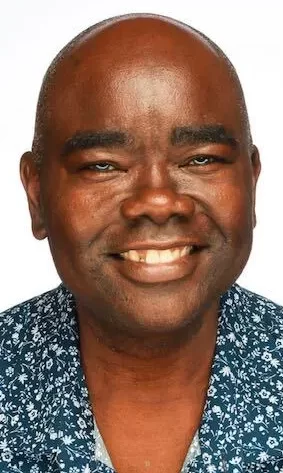 Now a government public information officer, an adjunct professor of journalism at San Diego State University and a “longtime journalist, he says poor pay and a lack of diversity are two main issues that plague American newsrooms today,” Anissa Durham wrote for Word in Black.
Now a government public information officer, an adjunct professor of journalism at San Diego State University and a “longtime journalist, he says poor pay and a lack of diversity are two main issues that plague American newsrooms today,” Anissa Durham wrote for Word in Black.
“While reflecting on his nearly 35-year career, he says it’s always been difficult to be one of the only Black journalists in a newsroom. One of the most toxic experiences he remembers was in Portland, Oregon, between 2014-2015, when he was promoted to a management position, but it quickly took its toll.
“ ‘I had employees call me the N-word to my face,’ McCormick says. ‘I still have PTSD. Whenever I think about that time, I physically get ill because I was so poorly mistreated.’ ”
McCormick was executive producer at KOIN-TV in Portland from 2014 to 2015.
He declined to elaborate on the experience Wednesday, messaging, “It’s a part of my past I would like to not dwell on.”
Durham continued, “Unethical treatment of Black reporters not only poisons the aspirations of journalists, it directly impacts the kind of coverage Black communities receive. . . .”
[Gary Weitman, executive vice president and chief communications officer of Nexstar Media Group, messaged Journal-isms Thursday, saying of McCormick, “I can tell you that what he says he experienced is extremely unfortunate and wrong. While I can’t speak to the specifics of what happened back then during his employment at the station, this type of conduct would be wrong no matter where it took place.
[“KOIN was owned by a different company those many years ago, and the management team was totally different from the team in place today. I can also assure you that Nexstar, which now owns KOIN, takes the issue of Diversity, Equity and Inclusion seriously; diversity and respect are core values at the company.”]
Nonprofit Newsrooms More Diverse Than Others
Nonprofit news organizations appear “to be more diverse than other parts of the industry,” the Institute for Nonprofit News reported Tuesday.
The “INN Index 2023: Report on Diversity, Equity and Inclusion in the Nonprofit News Sector” “identified a disconnect between goals and practice, with more than half of newsrooms setting goals for improving diversity but far fewer creating a plan of action for achieving DEI goals or allocating resources for evaluating progress.”
In addition, “the degree of diversity is stronger at the staff level than at the leadership level in nonprofit news organizations. More than two-thirds of nonprofit outlets surveyed are white-led, which we define as organizations in which more than 50% of all executives and managers are white. This is roughly four times the number of outlets led by Black, Indigenous, and People of Color (BIPOC).”
The institute, a membership organization of more than 425 nonprofit newsrooms, recommended that funders pay greater attention to BIPOC-led newsrooms, saying, “For the effects of this much-needed investment to take root and offer more stability to these newsrooms, funders will need to match and continue their commitments to BIPOC-led and BIPOC-serving grantees beyond one-time grants, and support sustained multi-year, general operating funding.”
- American Press Institute: API launches second Inclusion Index cohort to better engage communities of color in Pittsburgh
- Daniel Golden, ProPublica: Local Newspapers Are Vanishing. How Should We Remember Them? (Oct. 14)
- Investigative Post, WVFO, Buffalo: Ja’ciel discusses diversity in journalism on WBFO
- Los Angeles Times: Rebecca Plevin joins the Los Angeles Times as the reporter for its equity initiative
- Karen Rundlet, Essence: We Need Local Newsrooms That Serve Diverse Audiences For Our Democracy To Survive
- Sydney Trent, Washington Post: Race isn’t real, science says. Advocates want the census to reflect that.
The Monday newscast of ICT, formerly Indian Country Today, visited the red carpet and Osage consultants who worked on the film “Killers of the Flower Moon.”
Natives Weigh In on ‘Killers of the Flower Moon’
“Spellbinding, heartbreaking and exhaustingly researched, director Martin Scorsese’s long-gestating epic look into the mass murders of the Osage over oil rights in the 1920s opens . . . in wide release across the United States,” Sandra Hale Schulman wrote for ICT, formerly Indian Country Today, a day before the Friday opening.
“Even getting the story to the big screen was not without drama – requiring a rewrite of the entire script, a change in the lead role from hero to villain for one of the movie’s biggest stars, recreation of a 100-year-old town, the hiring of dozens of Osage extras, a pandemic shut down, and finally a premiere at the Cannes Film Festival in France to rave reviews and a nine-minute standing ovation,” Schulman wrote.
On Sunday, Rebecca Rubin reported for Variety that the film “impressed in its box office debut, collecting $23 million from 3,628 North American theaters over the weekend. The film also brought in $21 million from 63 international territories for a global total of $44 million.”
Rubin added, “Despite its second-place finish, it’s easily the best start for Scorsese since 2010’s ‘Shutter Island’ ($41 million debut) and the third-best of his career following 2006’s ‘The Departed’ ($26.9 million debut). And ‘Killers of the Flower Moon’ managed to make a splash even though its stars, Leonardo DiCaprio and Robert De Niro, haven’t been able to promote the film amid the ongoing actors strike. . . .”
At least three mainstream media outlets, the BBC, The Wrap and The Washington Post, ran critiques or commentary of the film by Indigenous writers.
The film is adapted from the book by the same name authored by New Yorker writer David Grann.
- Haili Blassingame, WAMU-FM, Washington: The 1A Movie Club sees ‘Killers Of The Flower Moon’
- Laura Clark, The Wrap: ‘Killers of the Flower Moon’ and Why Native Stories Should Be Told by Native Filmmakers
- Barry Levitt, Daily Beast: ‘Killers of the Flower Moon’ Has the Best Ending of the Year
- Dennis McAuliffe Jr., Washington Post: What ‘Killers of the Flower Moon’ taught my Oklahoma town
- Aja Romano, vox.com: The horrifying, nearly forgotten history behind Killers of the Flower Moon
Harry Porterfield Dies, ’85 Demotion Led to Boycott
“Beloved Chicago television news broadcaster Harry Porterfield, who for years shared the unique tales of hundreds of area residents through his signature ‘Someone You Should Know’ series, died Monday,” Mitch Dudek reported for the Chicago Sun-Times. “He was 95.”
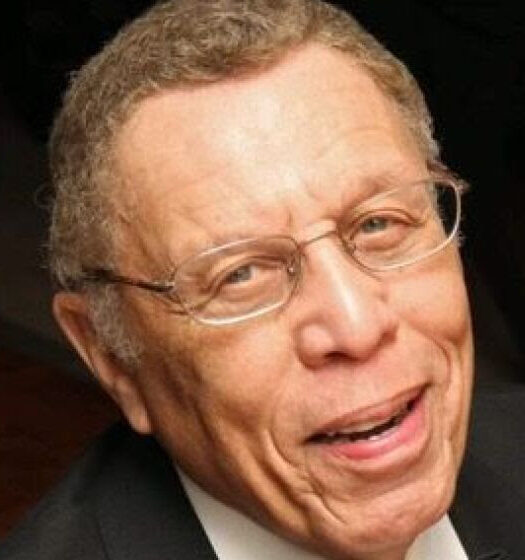 Dudek also wrote, “His job change in 1985 was sparked by a demotion to make room for news anchor Bill Kurtis at WBBM. Mr. Porterfield’s departure from WBBM, which some saw as forced, prompted the Rev. Jesse L. Jackson to orchestrate a 10-month viewer boycott against the station that resulted in an agreement to increase minority hiring.
Dudek also wrote, “His job change in 1985 was sparked by a demotion to make room for news anchor Bill Kurtis at WBBM. Mr. Porterfield’s departure from WBBM, which some saw as forced, prompted the Rev. Jesse L. Jackson to orchestrate a 10-month viewer boycott against the station that resulted in an agreement to increase minority hiring.
“Mr. Porterfield, who had been the station’s only African American weekday news anchor, was proud the end result was more job opportunities for minority journalists.”
Dudek wrote that Porterfield’s “first profile for the series aired on WBBM-TV Channel 2 in 1977 and featured a paralyzed woman who worked as a hospital receptionist and operated a switchboard using a device she clutched in her teeth, family said.
“Mr. Porterfield died Monday morning from natural causes while surrounded by his family in Munster, Indiana.
“The idea to showcase people in the community doing extraordinary things quickly resonated with viewers. . . .
“Mr. Porterfield stayed in touch with many of the people he profiled, said Dorothy Tucker, an investigative reporter with WBBM-Channel 2 and past president of the National Association of Black Journalists.
“ ‘Harry was for real. He was genuine. When I came to the station in 1984 I was a young reporter, and Harry always let me know he was there for support and to answer questions and for guidance and to listen and just be there,’ she said.
“ ‘We all looked up to Harry as the statesman in the newsroom. He never got rattled or angry. He was always calm and the voice of reason,’ Tucker said.
“Mr. Porterfield started his Chicago broadcast career at WBBM-Channel 2 in 1964 and spent 21 years at the station before moving to WLS-TV Channel 7 in 1985, where he worked for 24 years. He returned to WBBM in 2009 and retired in 2015 at age 87. . . .”
To subscribe at no cost, please send an email to journal-isms+subscribe@groups.io and say who you are.
Facebook users: “Like” “Richard Prince’s Journal-isms” on Facebook.
Follow Richard Prince on Twitter @princeeditor
Richard Prince’s Journal-isms originates from Washington. It began in print before most of us knew what the internet was, and it would like to be referred to as a “column.” Any views expressed in the column are those of the person or organization quoted and not those of any other entity. Send tips, comments and concerns to Richard Prince at journal-isms+owner@
View previous columns (after Feb. 13, 2016).
View previous columns (before Feb. 13, 2016)
- Diversity’s Greatest Hits, 2018 (Jan. 4, 2019)
- Book Notes: Is Taking a Knee Really All That? (Dec. 20, 2018)
- Book Notes: Challenging ’45’ and Proudly Telling the Story (Dec. 18, 2018)
- Book Notes: Get Down With the Legends! (Dec. 11, 2018)
- Journalist Richard Prince w/Joe Madison (Sirius XM, April 18, 2018) (podcast)
- Richard Prince (journalist) (Wikipedia entry)
- February 2018 Podcast: Richard “Dick” Prince on the need for newsroom diversity (Gabriel Greschler, Student Press Law Center, Feb. 26, 2018)
- Diversity’s Greatest Hits, 2017 — Where Will They Take Us in the Year Ahead?
- Book Notes: Best Sellers, Uncovered Treasures, Overlooked History (Dec. 19, 2017)
- An advocate for diversity in the media is still pressing for representation, (Courtland Milloy, Washington Post, Nov. 28, 2017)
- Morgan Global Journalism Review: Journal-isms Journeys On (Aug. 31, 2017)
- Diversity’s Greatest Hits, 2016
- Book Notes: 16 Writers Dish About ‘Chelle,’ the First Lady
- Book Notes: From Coretta to Barack, and in Search of the Godfather
- Journal-isms’ Richard Prince Wants Your Ideas (FishbowlDC, Feb. 26, 2016)
- “JOURNAL-ISMS” IS LATEST TO BEAR BRUNT OF INDUSTRY’S ECONOMIC WOES (Feb. 19, 2016)
- Richard Prince with Charlayne Hunter-Gault, “PBS NewsHour,” “What stagnant diversity means for America’s newsrooms” (Dec. 15, 2015)
- Book Notes: Journalists Follow Their Passions
- Book Notes: Journalists Who Rocked Their World
- Book Notes: Hands Up! Read This!
- Book Notes: New Cosby Bio Looks Like a Best-Seller
- Journo-diversity advocate turns attention to Ezra Klein project (Erik Wemple, Washington Post, March 5, 2014)

